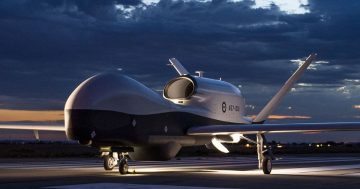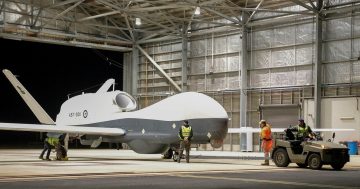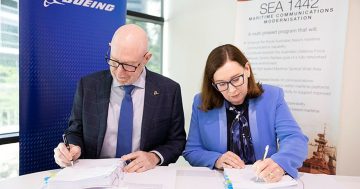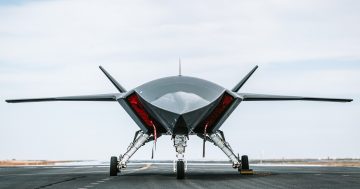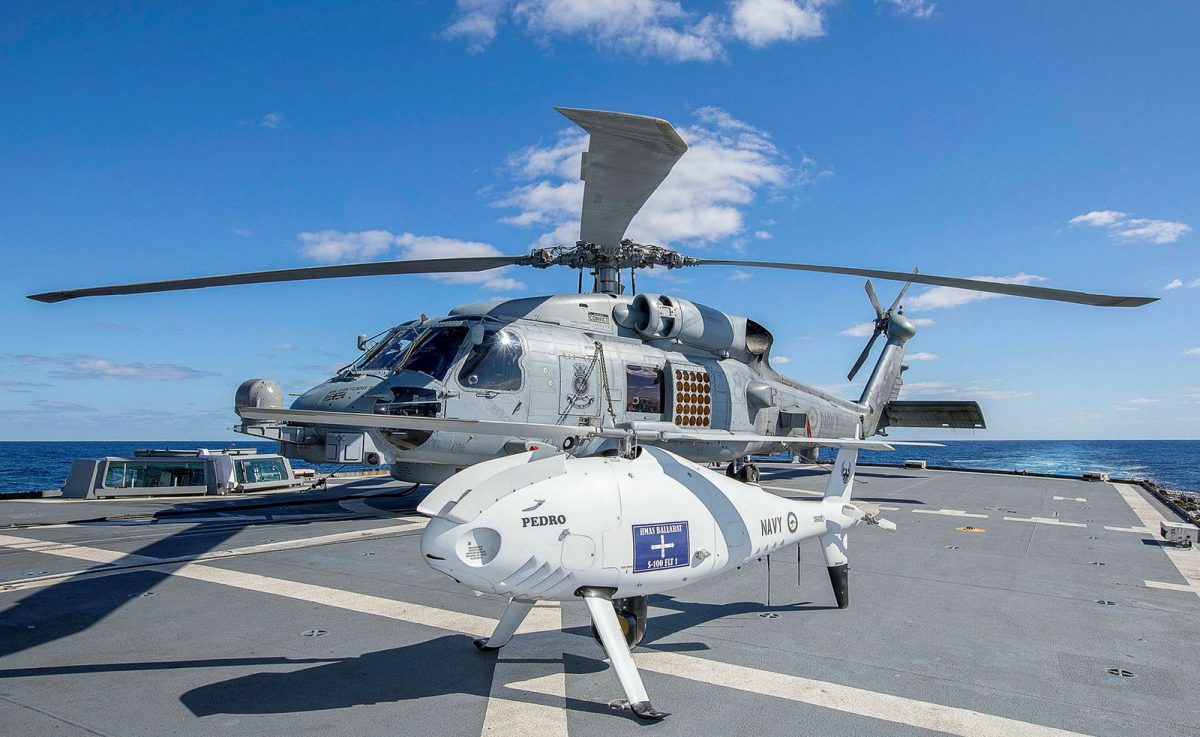
An S-100 alongside a larger, crewed MH-60R Romeo Seahawk aboard HMAS Ballarat in 2021. Photo: ADF.
The Royal Australian Navy has retired a small fleet of six Schiebel S-100 Camcopter uncrewed aerial systems.
Along with the fixed-wing Insitu ScanEagle, the Camcopter uncrewed system was operated by the navy’s 822X Squadron at HMAS Albatross at Nowra as a trials platform, initially under the uncapitalised Navy Minor Project (NMP) 1942 Maritime Tactical Unmanned Aircraft System – Interim Capability (MTUAS-IC) program.
NMP 1942 sought to develop concepts of operations and a requirements list for the navy’s larger SEA 129 Phase 5 Stage (later Block) 1 and 2 UAS programs originally planned for the Hunter-class frigates. In 2018, 822X SQN was stood up to develop those concepts and to conduct land-based and limited ship-borne deployments of both systems.
The motorcycle-sized Camcopter has a carbon-fibre and titanium fuselage and a maximum takeoff weight of 200 kg, and can carry a 34 kg payload of electro-optic/infrared (EO/IR), signals intelligence (SIGINT) or electronic warfare (EW) sensors for up to 10 hours. It has a maximum speed of around 180 km/h and is powered by a 41kW piston engine or a newer heavy-fuel engine.
The aircraft can fly fully autonomously over a pre-determined course, or it can be operated from a pilot control unit with missions planned and controlled via a simple point-and-click graphical user interface. High-definition payload imagery is transmitted to the control station in real time.
The integration of the heavy-fuel engine was the final hurdle before the start of shipboard trials in 2018, and allowed the aircraft to share the same fuel as used by a ship’s gas turbine engines rather than having to use separate and more volatile aviation gasoline (avgas).
The Camcopter was also demonstrated to the Australian Army in 2018 and 2019 for its LAND 129 Phase 3 tactical UAS requirement, and Schiebel later teamed with Raytheon Australia for that and the navy’s programs. However, the army tender was awarded in 2022 to Insitu Pacific with its Integrator UAS.
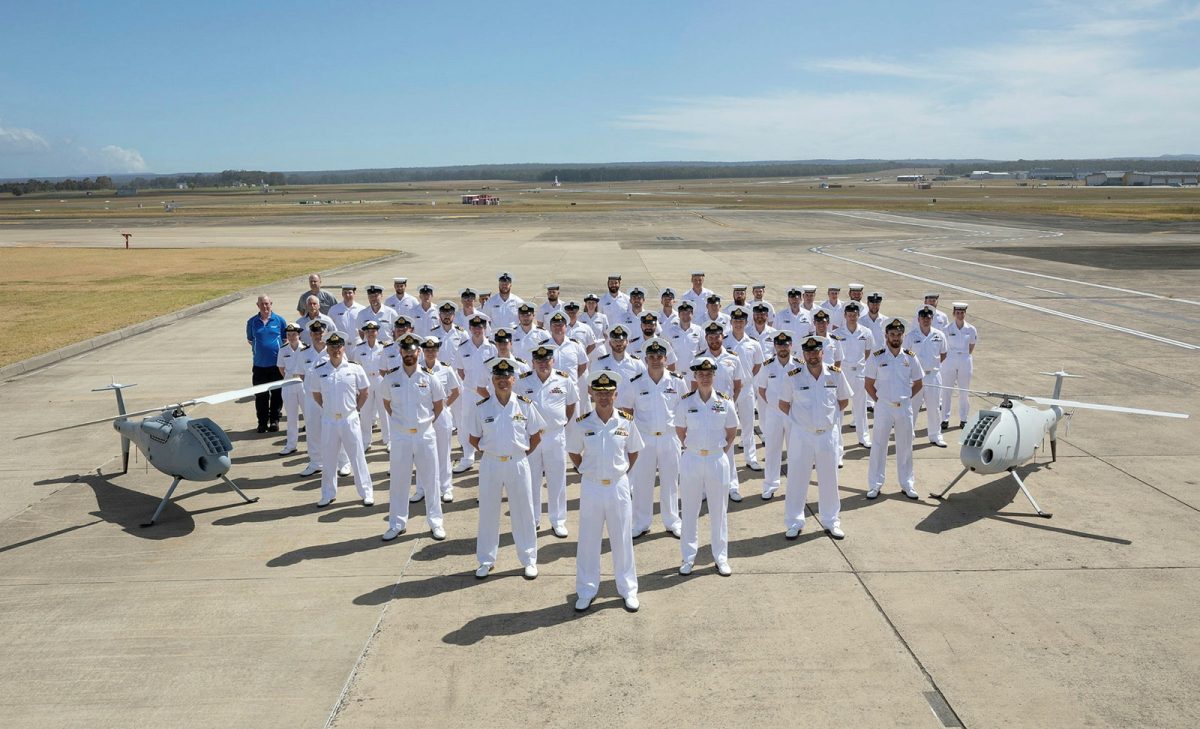
The navy’s 822X SQN poses with two S-100s at Nowra in 2023. Photo: ADF.
In July 2021, the NMP 1942 program was transferred to the Capability Acquisition & Sustainment Group (CASG) as part of the SEA 129 Phase 5 MUAS Continuous Development Program, and the contract with Schiebel to develop the system was extended by three years to June 2024.
As part of the contract extension, Schiebel Pacific developed a sovereign Australian training capability for the system and provided field support services and logistics.
“The S-100 fleet now forms part of SEA 129-5’s risk mitigation, workforce growth, tactics development, and operational test and evaluation activities,” a Defence spokesman said at the time.
Just before the May 2022 federal election, it was announced that the navy had shelved its SEA 129 Phase 5 Block 1 program and would instead make a sole-source acquisition of about a dozen S-100s.
Five companies, including Textron Australia, a Northrop Grumman and Leonardo teaming, Insitu Pacific, and BAE Systems Australia had pitched systems for SEA 129 Phase 5-1, and those companies were reportedly told in April 2022 that the program would not proceed to tender in favour of the Camcopter.
But in September 2023, the Camcopter was dropped as part of the 2023 Defence Strategic Review (DSR), which had been commissioned by the Labor Government, while the future of SEA 129 Phase 5 remains unclear.
In a 2 July post on LinkedIn, Schiebel Pacific described the retirement as “bittersweet”.
“It was an honour to work with incredible talented and motivated people and support Navy in progressing their UAS capability,” the post read.
“We are keen to learn what the future plans are and are motivated to demonstrate our new capability upgrades and the larger S-300 platform soon.
“Looking back to eight successful and exciting years of the CAMCOPTER S-100 fleet being in service for the Royal Australian Navy! Immensely proud that we trained and qualified over 100 RAN staff and supported in multiple deployments.
“After the initial three-year contract period, and one S-100 system, the contract was extended several times, with six S-100s in total participating in important exercises and missions. We are committed to further supporting the RAN for any upcoming VTOL UAS requirements.”


